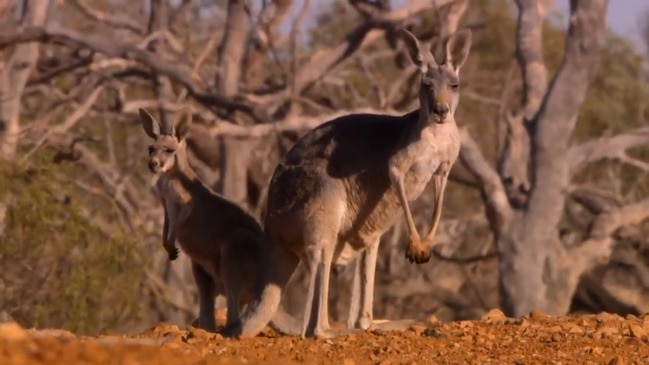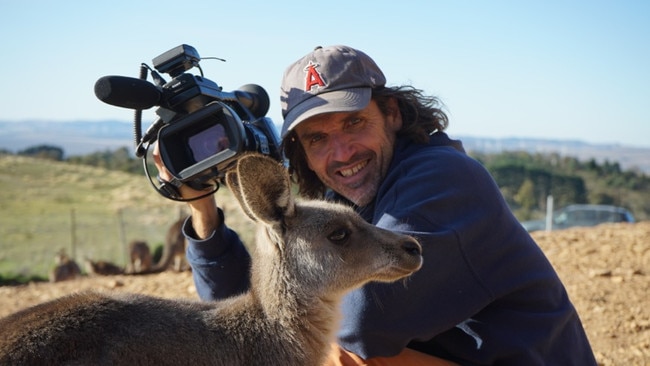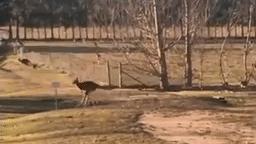Kangaroo: A Love-Hate Story in exposing the brutality of Australia’s ongoing kangaroo cull
The kangaroo. It’s not easy to define what they mean to Australia: A sentimental national icon or reviled pest? An Aussie film is challenging the paradigm, and enraging many along the way.

SA Weekend
Don't miss out on the headlines from SA Weekend. Followed categories will be added to My News.
- 2019: Kangaroos under fire as drought hits hard
- 2018: Push for non-commercial kangaroo cull as roos cause havoc
- 2018: Kangaroo cull proposal by SA Water angers local residents
Where to start? With night-vision footage of a commercial shooter holding a joey by the tail and smashing it to death against his bull bar?
By slamming the official population estimate of 50 million kangaroos as wildly inflated? By driving home Australia’s appalling extinction rate?
Or by trying to explain our schizoid approach to the kangaroo – sentimental national icon on one hand, reviled pest on the other?
These were some of the creative decisions facing filmmaking couple Mick and Kate McIntyre as they made their controversial documentary, Kangaroo: A Love-Hate Story.
It is not the film they planned to make, Mick says.
“When we set out to make it, we didn’t know there was a commercial industry of this scale or that the commercial industry had replaced culling,” said the Bondi filmmaker.
“We had no idea the Australian and state governments were so complicit in it and that it hadn’t been publicly scrutinised.”
The film comes in firmly on the side of roos and it has earned the rage of hunters, the slander of shock jocks, the opprobrium of National Farmers’ Federation president Fiona Simson and the endorsement of scientists putting their reputations on the line and animal welfare organisations such as Voiceless and a local organisation it funds, Tasmania’s Wildlife Matters.
“There are not 50 million kangaroos in Australia,” says McIntyre, disputing the official population number cited against an allowable annual kill rate of up to 15 per cent of that estimate.
“This figure [which shows a dramatic rise in the past decade] comes from the Government’s so-called populations estimate, which are hyper-inflated extrapolations from the actual data count.”
He says the government’s data relies too heavily on counts in national parks and other reserved areas, where roo populations are generally higher than on and near farmland.

The kangaroo kill, he says, is the biggest wildlife slaughter in the world. Couple that with the animal’s slow rate of reproduction and the numbers look wobbly.
“The science is also unequivocal that kangaroo populations crash during droughts, with up to 100 per cent joey mortality and up to 70 per cent or more adult mortality,” he says.
“Droughts are also a time when shooting increases. The assertion that kangaroos have miraculously increased during drought, at biologically impossible rates, to some 50 million animals, is an absurdity.”
As he has toured the world with Kangaroo: A Love-Hate Story over the past year, McIntyre has called for a halt to the killing, with an estimated 31.5 million kangaroos killed in the past decade, many for a meat and hide industry now worth about $200 million annually.
Australia has the worst record in the world for mammal extinctions.
“And as far as solutions go, the precautionary principle in science dictates you stop something until you are sure everything is in order,” he says.
“The solution now is a moratorium while credible research is undertaken.
“The time to act is now, because our appalling record with extinction shows that Australia sits on its hands until a species is really threatened. You can almost predict that will happen with kangaroos.”
As well as conservation concerns based on what it says is an unsustainable harvest quota, the film flags cruelty issues and, to a lesser extent, food safety concerns.
Roo meat, once simply a pet food staple, has risen dramatically in popularity among chefs and homecooks over the past decade.

McIntyre says the industry insists it follows all the Government guidelines relating to quotas, animal welfare, product handling and everything else.
But what good is that, he asks, when the guidelines are based on a false premise and voluntary, with most commercial hunting happening unmonitored at night in isolated and remote areas.
“We have been abused and threatened for making this film,” McIntyre says, adding he and Kate are considering making a solutions-based sequel.
“It’s taken a heavy toll on both of us, but we are very proud,” he says.
“On good days, I feel we’ve done a good job shining a light. On bad days, I’ll get abused and think ‘I was not ready for that level of aggression’.”
The abuse has happened at home, not overseas.
The film launched in New York just over a year ago, with another launch screening in California, where kangaroo products including meat and leather are banned.
McIntyre also took it on a seven-city tour of China and to Russia, where the sale of kangaroo meat has since been suspended.
Numerous screenings were also held across Europe, including in the Dutch parliament at The Hague and the European Union parliament in Brussels.
He says international audiences were confounded by Australians’ love/hate attitude towards an animal borne on our coat of arms and after which we nickname many of our national sporting teams — the Wallabies, Socceroos, Hockeyroos etc.

Locally, the film was harshly received by industry and some media outlets.
Attempts to silence the filmmakers have included death threats from internet trolls. McIntyre attributes mockery of the film from some quarters to a stubborn refusal of those viewers to shift perspective.
“Having spent five years of my life on this subject, I now have a broader picture of what we did as white settlers,” he says. “What I’ve learnt is they really did want to turn Australia into a little Europe. They did really think they were going to bring the same farming practices to Australia – and when there were things in the way of that goal, they were dealt with, and that includes all the wildlife.
“When you have the idea that kangaroos are the problem and you can’t co-exist with them, that is handed down as a given through the generations – they don’t belong here, we don’t want them, let’s just get rid of them.”
He hopes his documentary helps shift that consciousness. “There is a lack of empathy and care for this magnificent icon that is fed by this hatred in the bush,” he says.
“The two form a perfect storm, in a way. The farmers just want to get rid of the kangaroos because they consider them competition [to sheep, cattle and crops] and the Government is happy to go along with it, because no one is saying anything.
“If we can say this film is a line in the sand where we can at least acknowledge what we have done to our wildlife, we can then decide what we are going to do next.”

Critics include National Farmers’ Federation president Fiona Simson. She said the documentary could jeopardise export markets and thousands of jobs.
“Certainly, when we look at some of the complete misinformation and shock tactics in this documentary, then it is absolutely portraying a picture of rural and regional Australia that is completely false,” she said.
The film was comparing the killing of kangaroos with the clubbing of baby seals, she added. “That is just atrocious, and I can’t think what the people involved in this film are thinking of. They are damaging Australia’s reputation … The [killing] is not done under the cover of darkness. The discussion is how we can benefit more from this wonderful resource.”
While acknowledging kangaroos were “a bit hard to count” Simson said numbers had increased to the current 50 million, up 23 million from 2010.
But in the film ecologist Ray Mjadwesch denounces official surveys as “critically flawed” and shares research he says shows a rapid decline in every commercial kangaroo killing zone in Australia.
“When you correlate [local kangaroo species] extinctions, it’s to farming land,” he says. “And where they appear in high density, they correspond to proximity to National Parks and other protected areas.”
Four months after the film’s release Mjadwesch was pleased to see the NSW Parks and Wildlife Service abandon its 40-year survey program, including its correction methodology. He is calling for other states to follow suit.

Another outspoken critic of current management and industry practices appearing in the film is former Federal Treasury chief Ken Henry. Moral philosopher and bioethicist Peter Singer is also interviewed, along with others including scientist and former Australian of the Year Tim Flannery, Australia Zoo’s Terri Irwin, government officials, farmers and industry spokespeople.
Not all interviewees concerned about the plight of the kangaroo believe it is at risk of extinction, but each articulates clear areas of concern. Once the filmmakers lined up their key talent including spokespeople from all interested parties, McIntyre says word spread the film was under way. And that’s when they started getting their gold: the whistle blowers started coming forward.
It is their stories and footage, often obtained at personal risk, that gives the film its shock value and its filmmakers what they say is indisputable evidence of cruelty by licensed commercial kangaroo shooters.
Scenes include the rough killing of joeys, the maiming rather than one-shot kill of animals and a massacre site near the Blue Mountains strewn with heads discarded from bodies after decapitation. Meanwhile, says McIntyre, the Government keeps spruiking kangaroo meat for export and domestic consumption. Game merchants promoting roo meat as a sustainable choice are green-washing, he says.
“It is very clever marketing. I sit here before you having witnessed the complete opposite. Find me a wildlife take where the animal doesn’t come off second-best.”
McIntyre says co-existence is the way forward, and any solution must involve landowners, including farmers – the traditional enemy of the kangaroo long before it made the leap onto your dinner plate.
Kangaroo: A Love-Hate Story will be released on DVD later this month and on iTunes from July. Preorder at kangaroo-themovie.com


